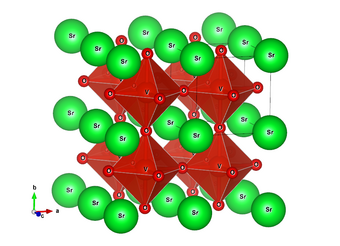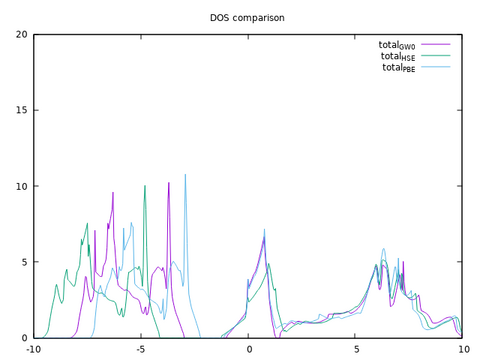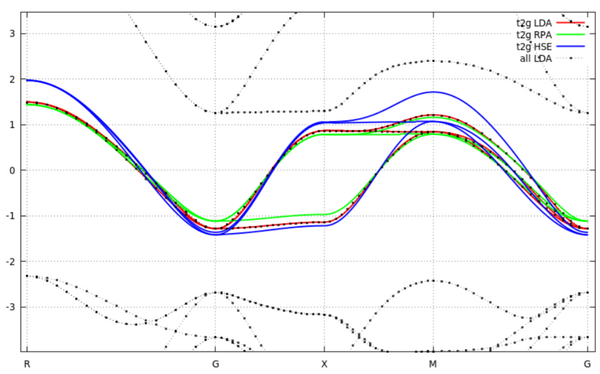Bandstructure of SrVO3 in GW
Task
Calculation of the GW bandstructure of SrVO3 using VASP and WANNIER90.
Performing a GW calculation with VASP is a 3-step procedure: a DFT groundstate calculation, a calculation to obtain a number of virtual orbitals, and the actual GW calculation itself. In this example we will also see how the results of the GW calculation may be postprocessed with WANNIER90 to obtain the dispersion of the bands along the usual high symmetry directions in reciprocal space.
N.B.: This example involves quite a number of individual calculations. The easiest way to run this example is to execute:
./doall.sh
And compare the output of the different steps (DFT, GW, HSE) by:
./plotall.sh
In any case, one can consider the doall.sh script to be an overview of the steps described below.
DFT groundstate calculation
The first step is a conventional DFT (in this case PBE) groundstate calculation.
- INCAR (see INCAR.DFT)
SYSTEM = SrVO3 # system name NBANDS = 36 # small number of bands ISMEAR = 0 # Gaussian smearing EDIFF = 1E-8 # high precision for groundstate calculation KPAR = 2 # parallelization of k-points in two groups
Copy the aforementioned file to INCAR:
cp INCAR.DFT INCAR
The POSCAR file describes the structure of the system:
SrVO3 3.84652 #cubic fit for 6x6x6 k-points +1.0000000000 +0.0000000000 +0.0000000000 +0.0000000000 +1.0000000000 +0.0000000000 +0.0000000000 +0.0000000000 +1.0000000000 Sr V O 1 1 3 Direct +0.0000000000 +0.0000000000 +0.0000000000 +0.5000000000 +0.5000000000 +0.5000000000 +0.5000000000 +0.5000000000 +0.0000000000 +0.5000000000 +0.0000000000 +0.5000000000 +0.0000000000 +0.5000000000 +0.5000000000
The POSCAR can be visualized with p4v or VESTA and remains unchanged in the following.
The KPOINTS file describes how the first Brillouin zone is sampled. In the first step we use a uniform k-point sampling:
- KPOINTS (see KPOINTS.BULK)
Automatically generated mesh
0
Gamma
4 4 4
0 0 0
Mind: this is definitely not dense enough for a high-quality description of SrVO3, but in the interest of speed we will live with it. Copy the aforementioned file to KPOINTS:
cp KPOINTS.BULK KPOINTS
and run VASP. If all went well, one should obtain a WAVECAR file containing the PBE wavefunction.
Obtain DFT virtual orbitals and long-wave limit
Use following INCAR file to increase the number of virtual states and to determine the long-wave limit of the polarizability (stored in WAVEDER):
- INCAR (see INCAR.PBE)
SYSTEM = SrVO3 # system name ISMEAR = 0 # Gaussian smearing KPAR = 2 # parallelization of k-points in two groups ALGO = Exact # exact diagonalization NELM = 1 # one electronic step suffices, since WAVECAR from previous step is present NBANDS = 96 # need for a lot of bands in GW LOPTICS = .TRUE. # we need d phi/ d k for GW calculations for long-wave limit
Restart VASP. At this stage it is a good idea to make a safety copy of the WAVECAR and WAVEDER files since we will repeatedly need them in the calculations that follow:
cp WAVECAR WAVECAR.PBE cp WAVEDER WAVEDER.PBE
Also make a backup of the charge density for later:
cp CHGCAR CHGCAR.PBE
The dielectric function
As a bonus, VASP determines the frequency dependent dielectric function in the independent-particle (IP) picture and writes the result to the OUTCAR and vasprun.xml files. In the OUTCAR you should search for
frequency dependent IMAGINARY DIELECTRIC FUNCTION (independent particle, no local field effects)
and
frequency dependent REAL DIELECTRIC FUNCTION (independent particle, no local field effects)
GW Step
The actual GW calculation requires a set of one-electron energies and eigenstates. In this case we use the PBE solution obtained from previous step:
cp WAVECAR.PBE WAVECAR cp WAVEDER.PBE WAVEDER
The following INCAR file selects the 'single shot' GW calculation also known as G0W0:
- INCAR (see INCAR.GW0)
SYSTEM = SrVO3 # system name ISMEAR = 0 # Gaussian smearing KPAR = 2 # parallelization of k-points in two groups ALGO = GW0 # GW with iteration in G, W kept on DFT level NELM = 1 # one electronic step suffices, since WAVECAR from previous step is present NBANDS = 96 # need for a lot of bands in GW PRECFOCK = Fast # fast mode for FFTs ENCUTGW = 100 # small energy cutoff for response function suffices for this tutorial NOMEGA = 200 # large number of real frequency points for Hilbert transforms of W and self-energy
Restarting VASP will overwrite the present WAVECAR and vasprun.xml file. Make a copy them for later.
cp WAVECAR WAVECAR.GW0 cp vasprun.xml vasprun.GW0.xml
HSE hybrid functional
To illustrate the kind of results one would obtain for SrVO3 using the DFT/Hartree-Fock hybrid functional HSE, without actually doing a full self-consistent calculation, we will recalculate the one-electron energies and DOS (ALGO=Eigenval) using the HSE functional with DFT orbitals as input
cp WAVECAR.PBE WAVECAR
Use the following INCAR file:
- INCAR (see INCAR.HSE)
SYSTEM = SrVO3 # system name ISMEAR = 0 # Gaussian smearing KPAR = 2 # parallelization of k-points in two groups ALGO = Eigenval # calulate eigenvalues NELM = 1 # one electronic step suffices, since WAVECAR from previous step is present NBANDS = 48 # small number of bands suffice PRECFOCK = Fast # fast mode for FFTs LHFCALC = .TRUE. # switch on Hartree-Fock routines to calculate exact exchange HFSCREEN = 0.2 # HSE06 screening parameter
Restart VASP and make a copy of the wavefunction for post-processing
cp WAVECAR WAVECAR.HSE
Post-processing: Density of states and Bandstructure for PBE, GW and HSE
Density of States
The DOS of the PBE, GW and HSE solution can be calculated in a post-processing step with
- INCAR (see INCAR.DOS)
SYSTEM = SrVO3 # system name ISMEAR = -5 # Bloechl's tetrahedron method (requires at least 3x3x3 k-points) ALGO = NONE # no electronic changes required NELM = 1 # one electronic step suffices, since WAVECAR from previous step is present NBANDS = 48 # number of bands used EMIN = -20 ; EMAX = 20 # smallest/largest energy included in calculation NEDOS = 1000 # sampling points for DOS LORBIT = 11 # calculate l-m decomposed DOS LWAVE = .FALSE. # do not overwrite WAVECAR LCHARG = .FALSE. # do not overwrite CHGCAR
and requires the apropriate WAVECAR file from one of the previous steps. Copy
cp WAVECAR.PBE WAVECAR
or
cp WAVECAR.GW0 WAVECAR
or
cp WAVECAR.HSE WAVECAR
and restart VASP. The density of states is written to DOSCAR, make a copy of this file
cp DOSCAR DOSCAR.XXX
where XXX is either PBE, GW0 or HSE. Visualize the projected DOS for the V-t2g, V-eg and O-p states with the scriptfile
./plotdos_comp.sh DOSCAR.???
This requires gnuplot to be installed.
Bandstructure with wannier90
The bandstructure can be calculated via Wannier interpolation using wannier90 in the library mode
- INCAR (see INCAR.WAN.XXX)
SYSTEM = SrVO3 # system name ISMEAR = 0 # Gaussian smearing ALGO = NONE # no electronic changes required NELM = 1 # one electronic step suffices, since WAVECAR from previous step is present NBANDS = 48 # number of bands used LWAVE = .FALSE. # do not overwrite WAVECAR LCHARG = .FALSE. # do not overwrite CHGCAR LWANNIER90_RUN = .TRUE. # run wannier90 in library mode # As of vasp-6.4.3 define wannier90 interpolation from INCAR as follows: # For older versions copy wannier90.win.XXX to wannier90.win and use INCAR.WAN as input for vasp NUM_WANN = 3 WANNIER90_WIN = " # use this energy window for t2g states for GW dis_win_min = 7.4 dis_win_max = 9.95 begin projections V:dxy;dxz;dyz end projections # plot bands bands_plot = true begin kpoint_path R 0.50000000 0.50000000 0.50000000 G 0.00000000 0.00000000 0.00000000 G 0.00000000 0.00000000 0.00000000 X 0.50000000 0.00000000 0.00000000 X 0.50000000 0.00000000 0.00000000 M 0.50000000 0.50000000 0.00000000 M 0.50000000 0.50000000 0.00000000 G 0.00000000 0.00000000 0.00000000 end kpoint_path "
| Mind: Prior VASP.6.4.3 a proper wannier90.win.XXX file should be used instead. |
Use the corresponding INCAR.WAN.XXX file as input for wannier90
cp INCAR.WAN.XXX INCAR
where XXX=PBE, GW0 or HSE.
Use the corresponding WAVECAR.XXX file as input
cp WAVECAR.XXX WAVECAR
and restart VASP. If all went well, the Vanadium t2g band dispersion thus obtained, may conveniently be visualized with gnuplot:
gnuplot -persist ./wannier90_band.gnu
- N.B.: Most modern versions of gnuplot will respond with an error message unless you remove the first line of wannier90_band.gnu (some deprecated syntax issue).
The preferred way to calculate the PBE bandstructure
Provided one has a self-consistent charge density (CHGCAR) file of sufficient quality (generated using a regular grid of k-points of sufficient density) one may read this charge density and keep it fixed (ICHARG=11). For density functional calculations this charge density completely defines the Hamiltonian and using this Hamiltonian one may non-selfconsistently determine the orbitals and corresponding eigenenergies at arbitrary k-points. This is a very convenient way to calculate the bandstructure.
First we copy the self-consistent charge density of one of our previous calculations:
cp CHGCAR.PBE CHGCAR cp WAVECAR.PBE WAVECAR
The bandstructure is conventionally plotted along lines of high symmetry in the 1st Brillouin zone. The easiest way to specify these is by means of the so-called linemode:
- KPOINTS (see KPOINTS.BSTR)
Auto 15 Linemode reciprocal 0.50000000 0.50000000 0.50000000 !R 0.00000000 0.00000000 0.00000000 !G 0.00000000 0.00000000 0.00000000 !G 0.50000000 0.00000000 0.00000000 !X 0.50000000 0.00000000 0.00000000 !X 0.50000000 0.50000000 0.00000000 !M 0.50000000 0.50000000 0.00000000 !M 0.00000000 0.00000000 0.00000000 !G
N.B.: using these k-points for a self-consistent calculation (ICHARG<10) would be a very bad idea since such and irregular sampling of the 1st Brillouin zone will not yield sensible charge densities.
Use the following INCAR file:
- INCAR (see INCAR.BSTR)
SYSTEM = SrVO3 # system name ISMEAR = 0 # Gaussian smearing EDIFF = 1E-7 # tight convergence criterion NBANDS = 36 # 36 bands are sufficient LWAVE = .FALSE. # do not overwrite WAVECAR LCHARG = .FALSE. # do not overwrite CHGCAR ICHARG = 11 # read the charge density from the CHGCAR file and keep it fixed LORBIT = 11 # compute lm-decomposed states EMIN = -20 ; EMAX = 20 # smallest/largest energy included in calculation NEDOS = 1000 # sampling points for DOS
N.B.: Mind that this approach works only for density functional calculations (e.g. PBE or LDA) and is not applicable to orbital dependent functionals (like hybrid functionals) or in case of GW calculations.
This PBE bandstructure and the Wannier-interpolated structures of the PBE, HSE and GW calculation can be compared via
./plotbands.sh
Download
Back to the main page.



